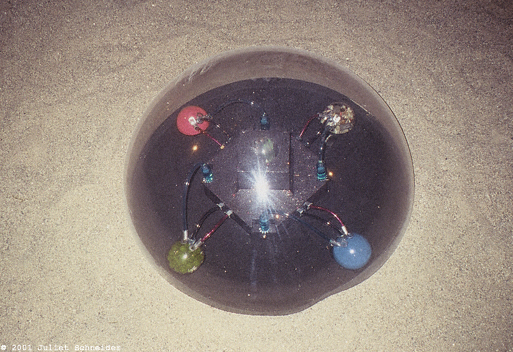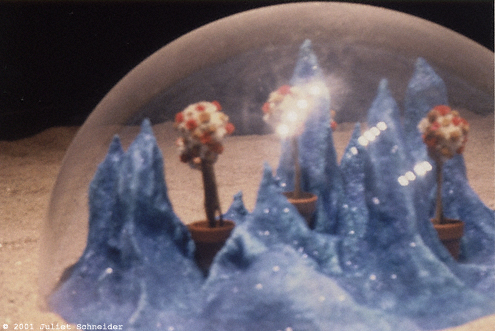In February 1997, My MFA thesis installation was on exhibit in the Tufts University Gallery at the Aidekman Arts Center. My installation represented an exploration of knowledge and growth in three forms – physical, spiritual, and intellectual. For me, it represented a measurement of my position at the time as a female artist, in relation to these themes. In the following paragraphs, I will provide a description of the installation and each of the five dioramas it contained.

The proportions of the room, 12’w x 18’l x 10’h, created an intimate interior space, physically separated from the surrounding gallery. The sense of physical separation was increased by the 3’w x 3’d x 10’h portal into the installation – designed to give the illusion of crossing into another world, or state of mind.The portal was framed by trees, moss, and flowers. This provided visual relief from the stark whiteness of the outer walls, while allowing a glimpse of the room’s dimly lit interior. The interior walls and ceiling of the room were painted/covered entirely in black with a 3” thick layer of coarse sand covering the floor. Embedded in the sand, were five, two foot diameter, dome-covered dioramas.
Passing through the garden-like portal into the installation created the effect of being transported to another world or state of mind. The proportion of human scale to the scale within the domed environments gave adults the sense of being giant, aloof observers – and children the sense of being more intimate participants in each of the fantasy worlds. The level of detail experienced by each person depended on his/her willingness to get close to the domes and peer inside. An important part of creating this installation was being able to observe people interacting with it. Not everyone was willing to crouch in the sand, preferring instead to gaze down at the environments from a standing position.
The air within the installation was thick with dust and humidity. There was a constant repetition of sound and light. The former – a chorus of female scientists ( The MIT Muses) singing “Twinkle Twinkle Little Star” in Latin- (Mica Mica Parva Stella), and the murmur of water in one of the domed environments. The latter – projected video of myself costumed as the goddess Flora, and the ever-changing colors of fiber optic light in the central domed environment.

The choice of five domed environments and their placement within the room is loosely based on the Chinese cosmological theory of a central world tree or axis mundi, with four trees at the corners, holding aloft the canopy of heaven. As far as the use of color is concerned within the installation – I took great liberties with the compass/color relationships of the Chinese system- and did not follow them at all. I merely used them as a reference point – allowing me to designate a predominant color for each of the environments, without adhering to the traditional placement of the colors in relation to the points on a compass.

The black diorama is centrally located in the room, and represents the axis mundi. It is a self-maintaining machine containing all known elements, dispensed into four planetary incubation chambers – each of these small domes corresponds to the larger dome opposite it in the room. This central dome is in itself, a reduced scale version of the entire installation – alluding to the overall theme of physical, spiritual, and intellectual growth.

The pink diorama represents physical growth. It is a desert world composed of pink sand, iridescent pink rocks, pink flowers, and moss. Two goddess scientist characters sit in the sand, playing a card game with the elements – thus generating compounds. The compounds held in the scientists’ hands are: Ca3(PO4)2 – calcium phosphate, NaCl – salt, and CO2 – carbon dioxide. The remaining element cards are scattered among the rocks and sand.

The green diorama represents the creation of the compound H2O and its necessity for life and physical growth. The goddesses’ feet are submerged in a circular pool of water, and they hold the element cards necessary to synthesize the compound – thus implying a cyclical nature to the process. They are surrounded by green grass and moss, and their heads are covered with flowers.

The blue diorama represents intellectual growth. It is composed of shimmering blue stalagmites with flower covered goddess heads growing in pots. The heads are symbolic of knowledge, and their placement in pots indicates that they can only grow so far before it becomes necessary to break out of bounds.

The silver diorama represents spiritual or cosmological growth. It depicts several goddesses interacting with planetesimals (partially formed planets). The video projected on the floor of this diorama depicts a veiled, nude feminine goddess, Flora, being “impregnated” with the seeds and flowers of the elements and follows the metaphorical “gestation and birth” of a planetesimal through the three states of matter (gas, liquid, and solid).